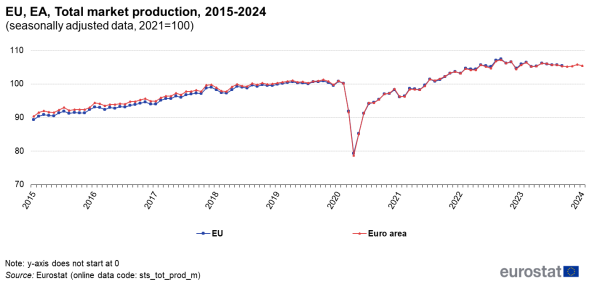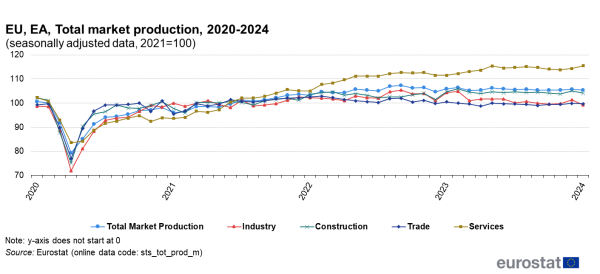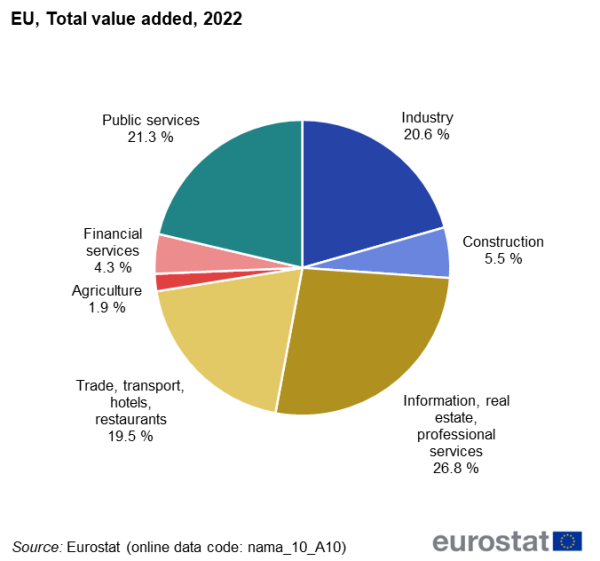Total market production (volume) index overview
Data extracted in April 2024
Planned update of the article: July 2024
Highlights
The total market production index (TMPI) is a new composite indicator that combines four short-term business statistics indicators covering most of the market economy, i.e. production in industry, construction and services as well as the deflated turnover index for distributive trades (see methodological notes for details). Due to the relatively wide coverage of the TMPI - industry, construction, trade and services except financial and public services - the index gives a first impression on the evolution of the European market economy every month.
Full article
Recent development of total market production
In January 2024, total market production decreased by 0.4 % in the European Union (EU) and in the euro area compared with December 2023. In December 2023, total market production had increased by 0.4 % in the EU and by 0.5 % in the euro area. The recent decrease in total market production in the EU was the result of decreases in industrial production, in construction, and in the trade volume. Services production increased in January 2024. Compared with the same month of the previous year, total market production decreased by 0.6 % in the EU and by 0.5 % in the euro area.

Source: Eurostat (sts_tot_prod_m)
Development of total market production and its components since 2015
Between January 2015 and February 2020, total market production grew by an average of 0.2 % per month in both the EU and the euro area (Figure 1). In March 2020, total market production fell by 8.3 % in the EU (-8.5 % in the euro area), while April saw a further fall of 13.6 % in the EU (-14.1 % in the euro area). In May, June and July, the total production index recovered rather quickly, but was still only around 94 % of its pre-crisis level. Since then, total market output has continued to rise (although not entirely steadily), reaching its pre-crisis level in the summer of 2021.

Source: Eurostat (sts_tot_prod_m)
The recovery after the Covid-19 shock in March and April 2020 in the EU was uneven across sectors. By June 2020, industry had reached 90 % of its February 2020 production level, construction 95 %, trade 97 % and services only 88 % (Figure 2). The slow recovery in services was largely due to lingering Covid-19 effects for hotels, restaurants and tourism in general. Since then, however, the evolution of the various sectors has changed. Between June 2020 and January 2024, total market production increased by 16 %. During this period, industrial production grew by 12 %, construction by 9 % and services production by as much as 29 %. This strong growth was mainly the result of a recovery in air transport, accommodation services and travel agencies, i.e. industries that had been hit most strongly by the Covid-19 pandemic. As a result of large price increases in 2021 and 2022, the trade volume only increased by around 3 % (up to December 2023).
Source data for tables and graphs
Methodology
Coverage
The total market production index (TMPI) covers industry, construction, trade and services, i.e. it combines all areas currently covered by short-term statistics (STS) indicators under the European Business Statistics Regulation (EBSR). In terms of NACE Rev. 2 the coverage of the TMPI is as follows:
- Industry: NACE sections B (mining and quarrying), C (manufacturing), D (electricity, gas, steam)
- Construction: NACE section F
- Trade: NACE section G, i.e. wholesale trade (G46), trade and repair of motor vehicles (G45), retail trade (G47)
- Services: Divisions H (transport), I (accommodation and food services), J (information and communication), L (real estate activities), M (professional and technical services), N (business support services)
The TMPI does not cover:
- Agriculture (NACE section A)
- Financial services (NACE section K)
- Public and quasi-public services (sections O, P, Q, R, S, T, U)
Given that agricultural activities now account for a relatively small share of national production, the TMPI can be considered as an indicator that covers most of the market-based part of the European economy, with the exception of financial services. There are also some areas that are not included in STS and thus also not in the TMPI, i.e.
- Water supply, waste management (NACE Section E)
- Activities of head offices (NACE group M70.1)
- Scientific research (NACE division M72)
- Veterinary services (NACE division M75)
The reasons for excluding these activities are of a technical nature (i.e. difficulty in compiling data, small share in total, low impact on the business cycle).
Figure 3 illustrates the share of the industries combined in the total market production index in the total value added (note that the shares are not exact due to the small exceptions mentioned above).

Reference period, delay and publication
The TMPI is compiled with a monthly reference period and should be available after about 65 days. The components of the TMPI are already available at an earlier date, i.e. retail trade volume after 30 days, industrial production after 40 days, and construction production after 45 days. Services production and total trade are available after 60 days. This Statistics Explained article will be updated every quarter.
Form and adjustment
Data for total market production are only published as an index (as is the case for the vast majority of STS indicators). The index base year is 2021. The TMPI will be produced for the EU, the euro area and, where possible in the future, for individual countries. It will be available in calendar adjusted and seasonally and calendar adjusted form (the adjustment is carried out by Eurostat).
Weights and calculation
As the TMPI is a production and volume indicator, the weights used to combine the different indicators for industry, construction, trade and services are value added. The indices from the different areas combined in the TMPI are the total production index for industry and construction, the total volume of trade indicator and the production indicator for services. The EU and euro area indices are weighted averages of the national indices of total market production (indirect method). The national total production indices are weighted averages of the monthly national production indicators for industry, construction, services and the volume of trade indicator. The coverage of the various monthly production indicators varies according to the availability of national data. For industrial production and retail trade full coverage is reached. In the case of construction production, monthly data are not available for some smaller countries that are only obliged to transmit quarterly data (Estonia, Ireland, Greece, Latvia, Lithuania, Luxembourg and Malta). Services production and turnover indicators for wholesale trade and trade in motor vehicles haven been added to the set of STS indicators with the European Business Statistics Regulation of 2019. Their coverage is not yet complete due to transition arrangements. Moreover, data for several countries are provisional.
So far, national statistical authorities do not transmit national indices of total market production to Eurostat, all calculations are done by Eurostat. Therefore, national data cannot be published at this stage. The total market production for the EU and the euro area are based on the data for those countries for which estimations are possible, i.e. Bulgaria, Czechia, Germany, Ireland, France, Croatia, Latvia, Lithuania, Hungary, Poland, Romania, Slovenia, Slovakia, Finland and Sweden.
For each component index and the TMPI, a national index is calculated if 80 % of the weights are available; European aggregates are calculated if 50 % (currently reduced threshold) of the country weights are available. If data are missing for the most recent period, the log-transformed (outliers excluded) SARIMA (011)(011) forecast is used instead.
Legal basis
The TMPI is a composite indicator produced by Eurostat based on the production indicators for industry, construction and services and the volume of trade indicator. These indicators have their legal basis in the European Business Statistics Regulation of 2019 and the Commission Implementing Regulation of 2020.
Context
STS indicators describe recent developments in the economies of the European Union and its Member States. STS indicators are important tools for the formulation and monitoring of economic and monetary policy in the EU and the euro area, and are in great demand by the European Commission and the European Central Bank, national governments and central banks, business and financial markets, research institutes and enterprises. STS has a number of flagship indicators for which monthly news releases are issued and many STS indicators are included in the set of Principal European Economic Indicators (PEEIs) and in the European Recovery Dashboard.
In 2022, industry, construction, trade and services (excluding financial and public services) accounted for around 72 % of total EU gross value added (see Figure 3 above). The main sectors not covered are agriculture (around 2 % of EU value added), financial intermediation (between 4 % and 5 % of EU value added) and public and quasi-public institutions (more than 21 % of EU value added). Due to the relatively wide coverage of the TMPI, it can be expected that the evolution of the total market production index will give a first impression of the evolution of total economic performance, but will not be identical to it. Figure 4 shows a comparison between the quarterly TMPI and the quarterly estimates of gross domestic product (GDP) for the EU between 2015 and 2023. As can be seen, the evolution of the two indices is quite similar, although there are also differences that become more pronounced with increasing distance from the base year. Apart from the limited coverage of the TMPI, there are several other methodological reasons for the differences between the TMPI and GDP:
- The STS indicators are indices based on value added in industry and construction. The output of services in STS is a turnover indicator deflated by an appropriate index of producer prices for services. The volume of trade is also calculated as deflated turnover data. A chain-linked volume indicator has been used for comparison with national accounts (NA).
- Data sources for STS and NA may differ. In some countries STS data are an important input for national accounts, but NA also uses several other sources.
- The compilation process and estimation techniques may differ between STS and NA.
- The weights used to calculate the indices used in STS are usually derived from structural business statistics and to a limited extent from NA.

Source: Eurostat (sts_tot_prod_m) and (namq_10_GDP)
The EU average absolute difference between the GDP index and the TMPI for the years 2015 - 2023 equals around 1 % of the GDP index. For the various sectors, the absolute differences between STS/TMPI and national accounts vary. The differences are relatively low for professional and business services (around 1 %) and for industry (around 2 %). Somewhat higher differences can be found for the combined sector of trade, transport, accommodation and food services (around 4 %), for communication (around 4 %), and for construction (around 4 %). The highest divergence can be observed for real estate services (almost 5 %). It should be noted that the differences between national accounts data and STS vary considerably between countries.
Direct access to
- Industry (t_sts_ind)
- Production in industry (t_sts_ind_prod)
- Construction, building and civil engineering (NACE F) (t_sts_cons)
- Production in construction (teiis500)
- Trade and services (t_sts_ts)
- Wholesale and retail trade (NACE G) (t_sts_wrt)
- Trade and services (t_sts_ts)
- Services (t_sts_ser)
- Industry (sts_ind)
- Production in industry (sts_ind_prod)
- Construction, building and civil engineering (sts_cons)
- Production in construction (sts_cons_prod)
- Trade and services (sts_ts)
- Wholesale and retail trade (NACE G) (sts_wrt)
- Trade and services (sts_ts)
- Services (sts_os)
- Short-term business statistics - Metadata in SDMX format (ESMS metadata file — sts_esms)